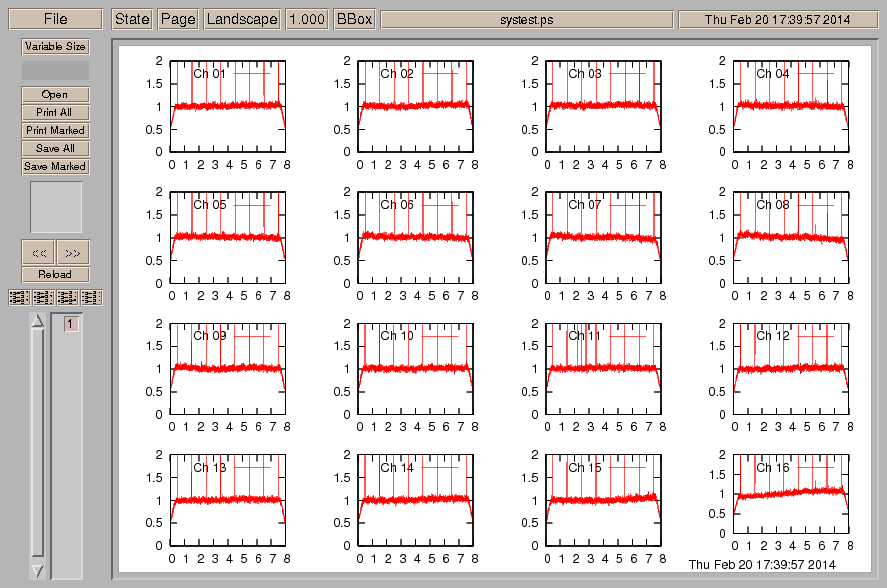Table of contents
Datacheck procedure for Mark5B
During testing and operation of the DBBC I often had to look at the data itself to verify that everything is okay. Usually I used the Mark5B tools from Haystack like bpcal, bstat, vlbi2 or vlbi0. Those work, but are mostly written for 2 Gbps PFB tests, or other 16 channel observation, and therefore can give confusing outputs when used with less channels.
During the TOG in Onsala Alessandra introduced the mark5access package.The mark5access package is much more flexible and can be used for all kind of VLBI data formats, like Mark5A, B, VLBA, or MarkIV and even some VDIF is supported. At the workshop in Bonn we had the idea to make an online display of VLBI data during recording.
Since the mark5access programs have to be called with the correct mode this was a bit complicated at the beginning. I tried to prepare scripts for the most common modes and attached those to each prc-file of an observation, but this needs an additional step after drudging and was a bit complicated.
As a result of the discussion at the TOG in Wettzelll I've now written a small python script that sorts out the required information from the current log file and prepares a shell script and a plot file for gnuplot. It is still not real time, but it can be executed after every scan in checkmk5 and does a check of the first few bytes from the last scan. It just uses a basic python installation, the mark5access package and gnuplot. mark5access should be installed on the Mark5B recorder. gnuplot is usually installed in every system. Since the FS PC has usually password free access to the Mark5 recorder one can execute programs via ssh. For now you get autocorrelation plot of all BBCs and the bit statistics (see images below).
If all the software is in place there is not much needed than adding a few lines to the checkmk5 procedure in your stations.prc to get it running. The installation of the mark5access package is explained in the INSTALL note within the tar-archive. I just had to install the fftw3 libraries to run it. The python script 'checkdata.py' should go to /home/oper/bin. The files are attached at the end of this page.
This is my new checkmk5 procedure:
define checkmk5 00000000000x
mk5=rtime?
scan_check
data_check
disk_stats
mk5=dir_info?
mk5=vsn?
mk5=disk_serial?
mk5=bank_set?
" query needed for checkdata.py
mk5b_mode
form
" write out some bytes from beginning of the last scan
!+1s
mk5=scan_set=::+20000000
!+1s
mk5=disk2file=systest.m5b:::w
!+3s
" run checkdata
sy=exec /home/oper/bin/checkdata.py `lognm` &
"
enddef
So first, a protion (20 MB) of data from the last scan are written to the disk. Then the python script is just looking for the correct mode in the log-file to sort out the correcrt parameters for m5spec and m5bstate that are used to check the data. The last lines in the script perform a scp to the mark5 to copy the gnuplot plotting script and to run the mark5access programs. The statistics are stored in a file, but all the other files that are written have always the same name and will be overwritten with the next scan. If somebody want to save those one could change the script to give them individual names.
For now I haven't add much information about the channels to the plots, but one could think of adding the correct sky frequencies as labels. The information could come form the prc-file, but as I tried that I gave up with observation that use more than one mode and one has to look which setup is used. Maybe I'll add this later.
Fig. 1: Here is a snapshot of the FS screen during a 1 Gbps 18cm observation with a lot of RFI.
Fig. 2: This plot is from N13C1 with 8 MHz filters and phasecal on.
/@api/deki/files/4326/=mark5access-1.4.5.tar.gz
/@api/deki/files/4330/=checkdata.py
Acknowledgment
Thanks to Jonathan Quick for the initial idea and for sending me the mark5access package and some gnuplot scripts to look at DBBC data.


